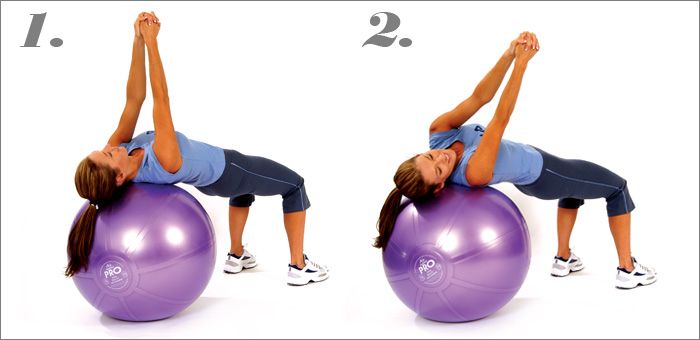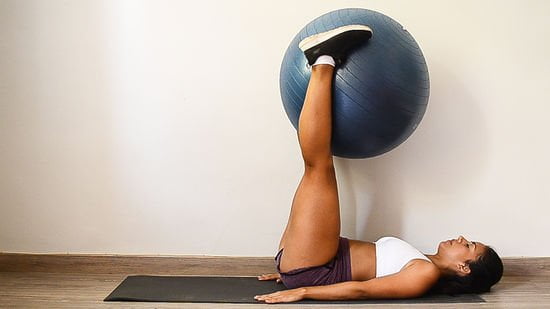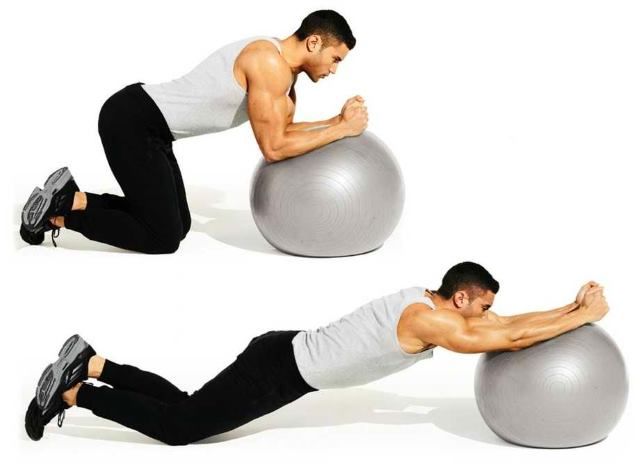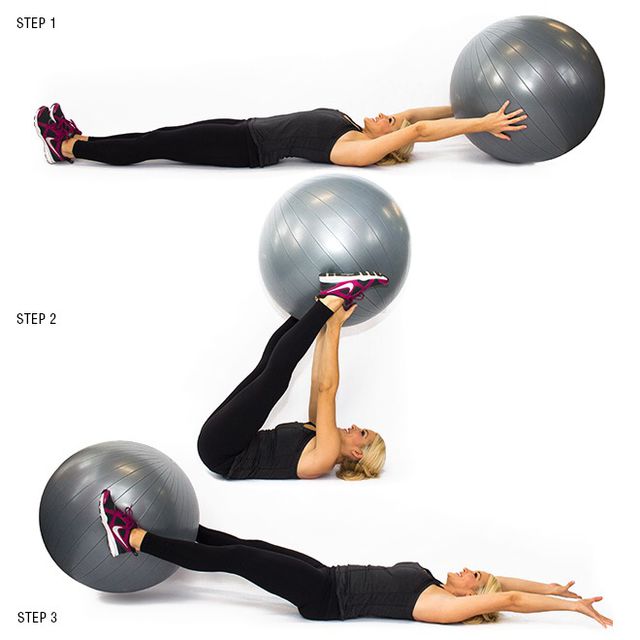Introduction
A solid core isn’t just about having a sculpted six-pack; it’s the foundation of your body’s strength and stability. Whether you’re an avid fitness enthusiast or simply looking to improve your overall health, stability ball exercises for the core are a fantastic way to achieve a rock-solid midsection. In this guide, we will unlock the secrets to a stronger core through a series of easy-to-follow stability ball exercises.
SHOP FOR THE BEST ADJUSTABLE DUMBBELL SET ON AMAZON
Imagine a fitness routine that not only strengthens your core muscles but also enhances your balance, posture, and overall well-being. That’s precisely what stability ball exercises offer. These exercises are accessible, effective, and, most importantly, enjoyable. Whether you’re a beginner venturing into the world of fitness or a seasoned athlete looking to spice up your workouts, stability ball exercises have something for everyone.
Why Choose Stability Ball Exercises for Core?
Stability ball exercises are a game-changer when it comes to developing core strength and toning your abs. Here’s why you should make them an integral part of your fitness routine:
- Enhanced Core Activation: Stability balls create an unstable surface, forcing your core muscles to work harder to maintain balance during exercises. This increased activation leads to more effective core strengthening.
- Versatility: Stability balls can be used for a wide range of core exercises, from beginner to advanced levels. You can modify exercises to match your fitness level and gradually progress as you get stronger.
- Improved Posture: A strong core is essential for maintaining good posture. Stability ball exercises target the muscles that support your spine, helping you stand and sit up straighter, reducing the risk of back pain.
- Engagement of Stabilizer Muscles: Beyond the primary core muscles, stability ball exercises engage stabilizer muscles throughout your body. This helps in building a balanced, functional, and injury-resistant physique.
- Injury Prevention: By strengthening your core, you can reduce the risk of injuries, especially in daily activities or sports that require twisting, bending, or lifting.
- Fun and Engaging: Stability ball workouts add an element of fun and variety to your fitness routine. They can be more enjoyable than traditional core exercises, which can help you stay motivated.
- Convenience: You can perform stability ball exercises at home or in the gym, and all you need is a stability ball. This makes it a cost-effective and accessible way to work on your core strength.
In summary, stability ball exercises for the core offer a holistic approach to core strengthening, targeting multiple muscle groups while improving balance, posture, and overall fitness.
How to Choose the Right Stability Ball?
Choosing the right stability ball, also known as an exercise or fitness ball, is crucial to ensure safety and effectiveness during your workouts. Here’s a brief explanation of how to select the right stability ball:
- Size Matters: The size of the stability ball is the most critical factor. It should be appropriate for your height. To determine the correct size, consider the following general guidelines:
- Under 5’4″ (162 cm): Opt for a 55 cm ball.
- 5’4″ to 5’11” (162-180 cm): Choose a 65 cm ball.
- Over 5’11” (180 cm): Go for a 75 cm ball.
- Weight Capacity: Check the weight capacity of the stability ball. It’s typically indicated on the packaging or in the product description. Ensure that the ball can support your body weight, plus a little extra for safety.
- Material Quality: Look for stability balls made from high-quality, anti-burst materials. These are designed to slowly deflate rather than burst if punctured, reducing the risk of injury.
- Inflation and Firmness: Inflate the ball to the appropriate size and firmness level. A properly inflated stability ball should have a slight give when you press on it, but it should not feel overly soft or squishy.
- Texture: Some stability balls have textured surfaces, which can provide extra grip and prevent slipping during exercises. Consider your preferences and the types of exercises you’ll be doing.
- Brand and Reviews: Do some research and read reviews of different stability ball brands. Well-known and reputable brands often offer better quality and durability.
- Purpose: Consider your specific fitness goals. If you’re planning to use the ball primarily for core exercises, a standard stability ball should suffice. However, if you intend to use it for activities like yoga or Pilates, you might want to explore specialty balls designed for those purposes.
- Storage and Portability: Think about where you’ll store the ball when it’s not in use. Some stability balls come with convenient storage solutions, like a stand or a bag, making it easier to keep your workout area organized.
- Price: While price is a consideration, it’s essential to prioritize quality and safety over cost. A good-quality stability ball is an investment in your health and fitness.
SHOP FOR THE BEST QUALITY STABILITY BALL ON AMAZON
In summary, choosing the right stability ball involves selecting the appropriate size based on your height, checking the weight capacity, ensuring high-quality and anti-burst materials, adjusting inflation and firmness, considering texture, and keeping your fitness goals and storage space in mind.
Essential Safety Guidelines for Stability Ball Workouts
While stability ball exercises are generally safe and effective, it’s important to follow these safety guidelines to prevent injury and ensure a successful workout:
- Check for Damage: Before each workout, inspect the stability ball for any signs of damage, such as punctures or excessive wear. Replace the ball if necessary.
- Maintain Proper Form: Pay attention to your posture and alignment throughout each exercise. Keep your core engaged, shoulders relaxed, and maintain a neutral spine.
- Gradual Progression: Start with beginner-level exercises and gradually progress to more challenging movements as your core strength and stability improve.
- Listen to Your Body: If you experience pain, discomfort, or excessive fatigue during an exercise, stop immediately. Consult a fitness professional if the issue persists.
- Clear Workout Space: Ensure you have enough space around you to perform the exercises without obstruction. A clear and padded area is recommended for added safety.
- Use on a Stable Surface: Place the stability ball on a flat, non-slip surface, such as a yoga mat or a clean floor. Avoid using it on uneven or slippery surfaces to prevent accidents.
- Use a Spotter (If Necessary): If you’re new to stability ball exercises or trying a challenging move, consider having a workout partner or spotter nearby to assist you and ensure your safety.
By following these safety guidelines, you can enjoy the benefits of stability ball workouts while minimizing the risk of injury. Remember that proper form, gradual progression, and caution are essential for a safe and effective workout on the stability ball.
Fundamental Stability Ball Exercises for Core Strength
Incorporate these fundamental stability ball exercises into your workout routine to develop a solid foundation of core strength:
- Basic Crunches
- Start by lying on the stability ball with your lower back supported.
- Cross your arms over your chest and contract your abs to lift your upper body toward your knees.
- Exhale as you crunch and inhale as you lower back down.
- Sets: 3
- Reps: 12-15
- Target Muscles: Rectus abdominis (six-pack muscles)
- Russian Twists

- Sit on the stability ball with your feet flat on the floor.
- Lean back slightly, engaging your core muscles.
- Hold a medicine ball or weight plate in front of you and twist your torso from side to side, tapping the weight on each side of your body.
- Sets: 3
- Reps: 10-12 (each side)
- Target Muscles: Obliques (side abs)
- Plank Rollouts
- Assume a kneeling position in front of the stability ball and place your forearms on the ball.
- Roll the ball forward by extending your arms and keeping your core engaged.
- Roll back to the starting position by pulling the ball back toward your body. Repeat for a challenging set.
- Sets: 3
- Reps: 8-10
- Target Muscles: Rectus abdominis, transverse abdominis, and obliques
- Leg Raises

- Lie flat on your back with your legs extended and the stability ball between your ankles.
- Lift your legs and the ball toward the ceiling, keeping them straight.
- Slowly lower your legs and the ball back down, maintaining control throughout the movement.
- Sets: 3
- Reps: 10-12
- Target Muscles: Lower abs and hip flexors
- Side Oblique Crunches
- Sit on the stability ball with your feet flat on the floor.
- Lean to one side, placing your hand behind your head.
- Crunch to the side, bringing your elbow toward your hip, and then return to the starting position.
- Repeat on the other side.
- Sets: 3
- Reps: 10-12 (each side)
- Target Muscles: Obliques and rectus abdominis
- Back Extensions
- Position yourself facedown on the stability ball, with your hips resting on the ball and your feet anchored against a sturdy object.
- Place your hands behind your head or across your chest.
- Lift your torso up off the ball, engaging your lower back muscles, and then slowly lower back down.
- Sets: 3
- Reps: 10-12
- Target Muscles: Erector spinae (lower back muscles) and glutes
Intermediate Stability Ball Exercises for Core
Once you’ve mastered the fundamental exercises, challenge yourself with these intermediate stability ball exercises to take your core strength to the next level:
- Pike Rollouts

- Assume a plank position with your forearms on the stability ball.
- Engage your core and roll the ball forward, lifting your hips toward the ceiling.
- Roll back to the starting position, maintaining control throughout the movement.
- Sets: 3
- Reps: 8-10
- Target Muscles: Rectus abdominis, transverse abdominis, and shoulders
- Bicycle Crunches
- Lie on the stability ball with your lower back supported and your hands behind your head.
- Lift one leg off the ball while simultaneously crunching, bringing your opposite elbow toward the lifted knee.
- Alternate sides in a bicycle-pedaling motion, engaging your core throughout the exercise.
- Sets: 3
- Reps: 12-15 (each side)
- Target Muscles: Obliques, rectus abdominis, and hip flexors
- Stability Ball Pass
- Lie on your back with your legs extended and the stability ball held between your ankles.
- Lift your legs and the ball toward the ceiling while simultaneously reaching overhead with your arms.
- Pass the ball from your legs to your hands, lower your legs and arms back down, and repeat.
- Sets: 3
- Reps: 10-12
- Target Muscles: Rectus abdominis and hip flexors
- Knee Tucks
- Start in a push-up position with your shins resting on the stability ball.
- Engage your core and pull your knees toward your chest, rolling the ball forward.
- Extend your legs back out to the starting position and repeat for the desired number of reps.
- Sets: 3
- Reps: 8-10
- Target Muscles: Rectus abdominis, transverse abdominis, and hip flexors
- Ball Bridge

- Lie on your back with your feet resting on the stability ball, knees bent.
- Lift your hips off the ground, forming a straight line from your shoulders to your knees.
- Hold the bridge position for a few seconds, focusing on engaging your glutes and core, then lower back down.
- Sets: 3
- Reps: 10-12
- Target Muscles: Glutes, hamstrings, and core stabilizers
- Reverse Crunches
- Lie on your back with your legs extended and the stability ball held between your feet.
- Lift your legs toward the ceiling, keeping them straight.
- Curl your hips off the ground, rolling the ball toward your chest, and then lower back down with control.
- Sets: 3
- Reps: 10-12
- Target Muscles: Lower abs and hip flexors
Advanced Stability Ball Exercises for Core
Ready to push the boundaries of your core strength and stability? Give these advanced stability balls exercises a try:
- Plank Pikes
- Assume a plank position with your feet on the stability ball and your hands on the ground.
- Engage your core and lift your hips toward the ceiling, forming an inverted V shape.
- Lower your hips back down to the starting position and repeat.
- Sets: 3
- Reps: 8-10
- Target Muscles: Rectus abdominis, transverse abdominis, shoulders, and triceps
- V-Ups

- Sit on the stability ball with your feet off the ground and your hands behind your head.
- Lean back slightly, engaging your core.
- Simultaneously lift your upper body and legs toward each other, forming a V shape, and then lower back down.
- Sets: 3
- Reps: 10-12
- Target Muscles: Rectus abdominis and hip flexors
- Stability Ball Jackknife
- Begin in a push-up position with your shins resting on the stability ball.
- Engage your core and roll the ball toward your chest, lifting your hips into the air.
- Roll the ball back out to the starting position and repeat.
- Sets: 3
- Reps: 8-10
- Target Muscles: Rectus abdominis, transverse abdominis, and shoulders
- Swiss Ball Pike Push-Up
- Start in a push-up position with your feet on the stability ball and your hands on the ground.
- Bend at the hips and lift your hips toward the ceiling, keeping your legs straight.
- Perform a push-up in this pike position, lowering your chest toward the ground and then pressing back up.
- Sets: 3
- Reps: 8-10
- Target Muscles: Chest, shoulders, triceps, and core stabilizers
- Russian Ball Twists
- Sit on the stability ball with your feet off the ground and your knees bent.
- Hold a medicine ball or weight plate in front of your chest.
- Twist your torso from side to side, tapping the weight on the ground on each side.
- Sets: 3
- Reps: 10-12 (each side)
- Target Muscles: Obliques and rectus abdominis
- Stability Ball Wall Rollouts
- Place the stability ball against a wall and lean against it with your forearms.
- Roll the ball up the wall by extending your arms, engaging your core.
- Roll the ball back down, maintaining control throughout the movement.
- Sets: 3
- Reps: 8-10
- Target Muscles: Rectus abdominis, transverse abdominis, and shoulders
Incorporating essential stability ball exercises for your core into your fitness routine can make a world of difference in your overall strength, balance, and posture. These exercises offer a dynamic and engaging way to target your core muscles, helping you build a solid foundation for better health and fitness.
Combining Stability Ball Exercises with Other Equipment
Combining stability ball exercises with other fitness equipment can be a highly effective way to add variety and challenge to your workouts. This approach not only keeps your routine fresh and exciting but also targets different muscle groups and enhances overall fitness. Here’s an explanation of how you can combine stability ball exercises with other equipment:
Dumbbells or Resistance Bands
- Incorporating dumbbells or resistance bands into stability ball exercises can increase the resistance and intensity of your workout.
- For example, while performing stability ball squats, you can hold dumbbells in each hand to work your upper body simultaneously.
- Resistance bands can be attached to a stable anchor point and used in conjunction with stability ball exercises to add tension and challenge to your movements.
Medicine Balls
- Medicine balls are great for adding resistance and variety to core exercises on a stability ball.
- For instance, during stability ball Russian twists, you can hold a medicine ball and rotate your torso to work your obliques and improve stability.
Bosu Ball
- Combining a Bosu ball with a stability ball creates a dynamic and unstable surface, challenging your balance and core stability even further.
- Exercises like the Bosu ball stability ball push-up involve balancing on both balls, engaging your core muscles extensively.
Kettlebells
- Kettlebells can be used in coordination with stability ball exercises to enhance functional strength and stability.
- For example, you can perform kettlebell goblet squats while balancing on a stability ball, engaging your core and lower body muscles.
TRX Suspension Trainer
- TRX straps can be attached to a sturdy anchor point, and stability ball exercises can be incorporated for a more intense full-body workout.
- Combining TRX chest press with a stability ball bridge, for instance, engages your chest, back, and core muscles simultaneously.
Barbells
Barbells can be used in conjunction with stability ball exercises like stability ball bench press or stability ball leg curls to challenge your strength and stability.
Pull-Up Bar
Hanging leg raises with a pull-up bar while balancing on a stability ball can provide an intense core workout, targeting your lower abdominal muscles effectively.
Yoga Mat or Exercise Mat
Placing a yoga mat or exercise mat under the stability ball can add comfort and stability when performing exercises on hard surfaces. It also prevents the ball from rolling away.
SHOP FOR THE BEST QUALITY RESISTANCE BAND ON AMAZON
When combining stability ball exercises with other equipment, it’s essential to prioritize safety and proper form. Start with lighter weights or resistance and gradually increase the intensity as your strength and stability improve.
FAQs
Q.1 How often should I perform stability ball exercises for the core?
Ans: The frequency of your stability ball workouts will depend on your fitness level and goals. As a general guideline, aim to incorporate core-focused exercises at least two to three times per week. Start with shorter sessions and gradually increase the duration as your core strength improves.
Q.2 Are stability ball exercises suitable for beginners?
Ans: Absolutely! Stability ball exercises can be adapted to suit all fitness levels, including beginners. Start with basic exercises and focus on maintaining proper form and stability. As your core strength improves, gradually progress to more challenging movements.
Q.3 Can stability ball exercises replace traditional ab workouts?
Ans: While stability ball exercises offer unique benefits, they should not completely replace traditional ab workouts. Instead, think of stability ball exercises as a valuable addition to your existing routine. Combining stability ball exercises with other core-strengthening exercises will provide a well-rounded approach to developing your abs and overall core strength.
Q.4 What are the benefits of stability ball exercises for core?
Ans: Stability ball exercises offer numerous benefits, including improved core strength, increased stability and balance, enhanced posture, and engagement of multiple muscle groups simultaneously. These exercises also challenge your core in a dynamic and functional way, helping you develop a strong, stable, and aesthetically pleasing midsection.
Q.5 Is it normal to feel instability when first using a stability ball?
Ans: Yes, feeling some instability when first using a stability ball is common. As you adapt to the ball’s unstable surface, your core and stabilizer muscles will gradually strengthen, resulting in improved stability and control. Start with basic exercises and gradually progress to more advanced movements as your stability and confidence increase.
Conclusion
Congratulations on completing this comprehensive guide to stability ball exercises for core strength and sculpting your abs! By incorporating these exercises into your workout routine, you’ll unlock a whole new level of core engagement, stability, and strength.
SHOP FOR THE BOSU BALLS ON AMAZON
Remember, consistency is key. Start with the basic exercises and gradually progress to more advanced movements as you gain confidence and strength. Listen to your body, maintain proper form, and challenge yourself within your capabilities.
Whether you’re a beginner or an experienced fitness enthusiast, stability ball exercises offer endless possibilities for strengthening your core and achieving those well-defined abs you’ve always wanted.

Good day, and welcome to Fitthour. My name is Shubham Vijay, and I am a certified personal trainer and nutrition coach with 6 years of experience in the fitness industry. At Fitthour, we specialize in types of training, such as strength training, cardio, or HIIT, and our mission is to help clients achieve their fitness goals and improve their overall health.




